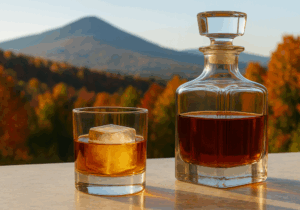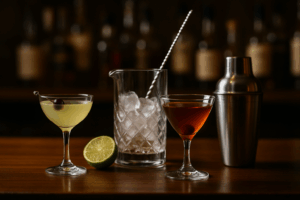The first drinks I made were often vodka-based or relied heavily on liqueurs and cordials. At the time, vodka’s clean simplicity and neutrality appealed to me, while gin felt like its eccentric cousin, infused with flavors I hadn’t learned to appreciate. Although my fledgling home bar had an unopened bottle of gin someone had given me, along with the requisite bottles of light and dark Bacardi rum, and an adequate tequila for margaritas, at the time, I would’ve told you I didn’t like gin at all. Thankfully, I’ve evolved since then, and as I write this, there are at least a dozen different gins in my bar.
While gin has a long, storied history (some of it less than glamorous), my first impression was far from positive. Traditional gins are heavy on juniper, sometimes so aggressively that it feels like drinking a fermented evergreen. The medieval, medicinal roots of the spirit are still perceptible, which might be why so many people have said to me, “I don’t like gin.” I held that same conviction for years.
In 2000, a friend and I were in New York City to support a mutual friend who used to organize an annual bar crawl of New York’s century-old establishments. People would fly in from around the world to attend. We didn’t join at the 10 a.m. Bloody Mary kickoff (which likely began at the King Cole Bar in The St. Regis Hotel), but by midday we met up with the group at The Landmark Tavern on 11th Ave, a great spot for Bass on tap. While I don’t remember the full order of every famous bar we hit, McSorley’s Old Ale House, PJ Clarke’s, Keens Steakhouse, White Horse Tavern and The Ear Inn were among some of the stops. It was a fun event, and I’m glad we joined a couple of the years it ran.
Amid the history and hustle of the day, one unexpected moment stood out, and it quietly challenged my long-held bias against gin. At a packed PJ Clarke’s, draft beers in hand, someone tried hard to convince us to try some gin. We gave our usual response: we don’t like gin. She turned out to be a rep from Tanqueray promoting their new product, Tanqueray No. Ten, which launched that year. We gave in and tried it.
To my surprise, it was… quite good. The juniper was more restrained, the citrus more forward, and the overall flavor smoother and cleaner than I expected. I was reluctant to admit it, but I liked it. Not long after, a bottle of it was an addition to my home bar, although I’ll admit at first it still did not get used all that much. And then in 2007, St-Germain Elderflower Liqueur was launched sparking a renewed interest in the spirit. Ultimately, this lead to me being introduced to the French Gimlet, a cocktail made with Hendrick’s gin and St-Germain. This was one of the first gin cocktails that really got my attention, and it was these newer-style gins that helped me see the spirit in a whole new light.
With time and curiosity, I found myself more open to the gin classics I had once dismissed. A properly made Martini with quality, extra-dry vermouth became something I genuinely enjoyed. Tasting inspired gin cocktails at great bars helped me refine my palate and understand what made each one work. I also began to appreciate just how wide-ranging modern gin styles could be, from citrus-forward profiles and floral blends to those with soft spice or herbal complexity. In some ways, I came to think of gin as vodka with flavor, a base spirit made interesting by its botanicals and complexity.
These days, gin is a staple in my bar and the base for many of my favorite cocktails. From The Last Word and Corpse Reviver #2 to a Bee’s Knees and a Negroni, these are the drinks that now define how I enjoy the spirit — bold, balanced and full of character.




